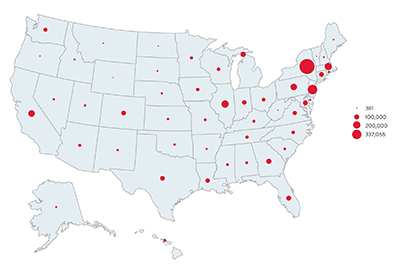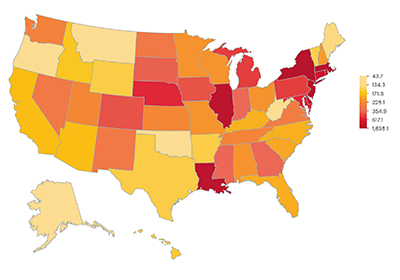COVID-19 is unlikely to be spread through semen, according to University of Utah Health scientists who participated in an international study of Chinese men who recently had the disease. The researchers found no evidence of the virus that causes COVID-19 in the semen or testes of the men.
The study was not comprehensive enough to fully rule out the possibility that the disease could be sexually transmitted. However, the chances of it occurring, based on this limited finding, appear to be remote.
“The fact that in this small, preliminary study that it appears the virus that causes COVID-19 doesn’t show up in the testes or semen could be an important finding,” says James M. Hotaling, M.D., a co-author of the study and a U of U Health associate professor of urology specializing in male fertility. “If a disease like COVID-19 were sexually transmittable that would have major implications for disease prevention and could have serious consequences for a man’s long-term reproductive health.”
The study appears in Fertility & Sterility, a peer-reviewed journal published by the American Society of Reproductive Medicine.
The international team of researchers from China and the United States launched the study in response to concerns that SARS-CoV-2, the virus that causes COVID-19, could be sexually transmitted like Ebola, Zika and other emerging viral pathogens. To find out, they collected semen samples from 34 Chinese men one month (on average) after they were diagnosed with mild to moderate cases of COVID-19. Laboratory tests did not detect SARS-CoV-2 in any of the semen samples.
But just because the virus wasn’t present in the existing semen didn’t necessary rule out that it hadn’t entered the testes where sperm cells are formed.
“If the virus is in the testes but not the sperm it can’t be sexually transmitted,” says Jingtao Guo, Ph.D., a postdoctoral scientist at the Huntsman Cancer Institute at the University of Utah who also co-authored the study. “But if it is in the testes, it can cause long-term damage to semen and sperm production.”
To sort this part of the puzzle out, the researchers analyzed a dataset generated from a single cell mRNA atlas from healthy young organ donors that was available from prior work. This atlas allows them to examine mRNA, the genetic material used to make proteins, in any single testicular cell. In this case, scientist used it to examine the expression of a pair of genes associated with SARS-CoV-2. These two genes, angiotensin-converting enzyme 2 (ACE2) and transmembrane serine protease 2 (TMPRSS2) act as receptors, allowing SARS-CoV2 to penetrate cells and replicate. In order for the virus to access cells effectively, both receptors must be present in the same cell.
When the scientists examined the dataset, they found that genes encoding these two proteins were only found in four of the 6,500 testicular cells, suggesting that SARS-CoV-2 is unlikely to invade human testicular cells, Guo says
Despite these findings, the researchers acknowledge that their study has several important limitations including a small sample size and the fact that none of the donors had been severely ill with COVID-19.
“It could be that a man who is critically ill with COVID-19 might have a higher viral load, which could lead to a greater likelihood of infecting the semen. We just don’t have the answer to that right now,” Hotaling says. “But knowing that we didn’t find that kind of activity among the patients in this study who were recovering from mild to moderate forms of the disease is reassuring.”
However, Hotaling warns that intimate contact can still increase the risk of spreading the disease through coughing, sneezing and kissing. In addition, some infected people are asymptomatic and can appear healthy, even as they pass the virus along to others.
In addition to Drs. Hotaling and Guo, other U of U Health researchers involved in this study titled, “No Evidence of SARS-CoV-2 in Semen of Males Recovering from COVID-19,” were Darshan Patel, MD, and Adam Spivak, MD. The research was supported by the National Natural Science Foundation of China and the Huazhong University of Science & Technology.
See original press release here.

